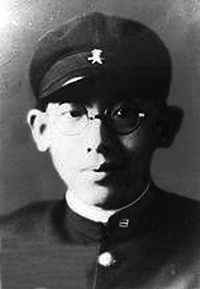Kaii Higashiyama

Higashiyama Kaii (東山 魁夷 July 8, 1908 - May 6, 1999) was a Japanese artist.
Life
Higashiyama Kaii was born in Yokohama, to parents Kosuke and Higashiyama Kaii. He was given the name Shinkichi, but later changed this to Kaii. He lived from 3 years old to 18 in Kobe.
In 1926 he graduated from Hyogo Prefectural Hyogo High School and entered the Nihon-ga department of Tokyo School of Fine Arts (currently Tokyo National University of Fine Arts and Music), and graduated with commendation in 1931. In 1940 Higashiyama married Sumi Kawasaki.
In July 1945, Higashiyama was drafted into the army and received anti-tank training. He was demobilized later that year. Higashiyama spent a lot of time travelling, mostly in Japan and China, but also made several trips to Europe. In 1933, he studied German at the Berlin University and in 1962 he travelled around the Nordic countries.
Artistic career
In 1947, Higashiyama received the special prize at "Nitten," the largest competition art exhibition in Japan. This led him to pursue seeking his own style, later found as a landscape is his major motif. In 1950, he exhibited a painting "the road," in which his simplicity was well recognized. He traveled Scandinavian countries, Germany, Austria, and China, and drew many works themed the sceneries of these countries.
Awards
- 1956 received the Japan Art Academy Award for "Twilight”
- 1965 appointed as a member of Japan Art Academy.
- 1969 ”Tide at Daybreak” won the Mainichi Art Award.
- 1984 Elected as a member of Order Pour De Le Merite Für Wissenschaften Und Künste.
- 1992 Awarded the UNESCO Picasso Gold Medal.
- 1994 Higashiyama Kaii art gallery was opened.
Murals
In 1953, Higashiyama was selected to paint 27 fusama-e murals for a Japanese House, called Shofuso, which was being constructed in Nagoya in 1953 for an exhibition at the Museum of Modern Art in New York. Higashiyama, who had been a classmate of architect Junzo Yoshimura, was chosen above a number of other well-known Japanese painters such as Maeda Seison and Yokoyama Taikan, to paint mountain scenes with black ink on the fusuma and the tokonoma alcove. Shofuso Japanese House was moved to Philadelphia in 1958 where the murals were on view until they were destroyed by vandals in 1974. In 1960, Higashiyama painted a large mural entitled ”Sun, Moon, and The Four Seasons”, at the Tōgū Palace of the Crown Prince. A second royal commission followed, resulting in the Imperial Palace's 1968 mural, “Tide at Daybreak.”
Higashiyama also painted several murals of Japanese and Chinese landscapes, for the Tōshōdai-ji temple, completed in 1975 and 1980.
Sources
- "Kaii Higashiyama: A retrospective". Nikkei inc. Retrieved 2008-07-01.
- "Kaii Higashiyama- The Japanese master". James Tan Gallery. Retrieved 2008-07-01.
- "Kaii Higashiyama biography". Higashiyama Kaii Setouchi Museum. Retrieved 2008-07-01.
- The collected works of Kaii Higashiyama. Shorewood Fine Art Books. OCLC 78302874.
- Yasunari Kawabata. Collection of Higashiyama-Kaii's Major Paintings. Tokyo: Shueisha Co.
External links
- http://www.lingnanart.com/J-master/J_master_Kaii_Higashiyama_eng.htm
- Artworks and history of Kaii Higashiyama
- NAGANO PREFECTURAL SHINANO ART MUSEUM / HIGASHIYAMA KAII GALLERY
|